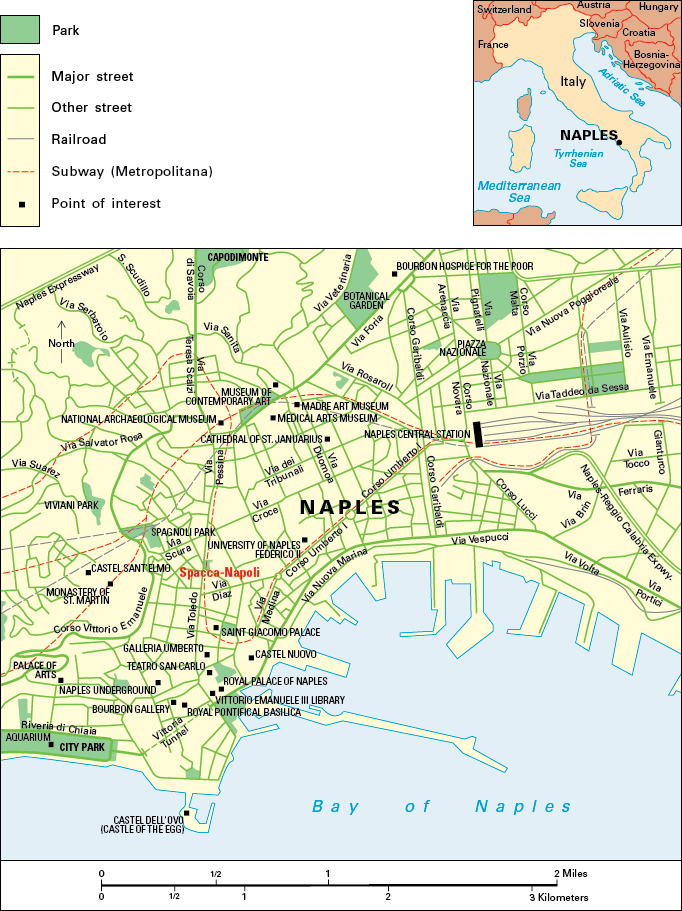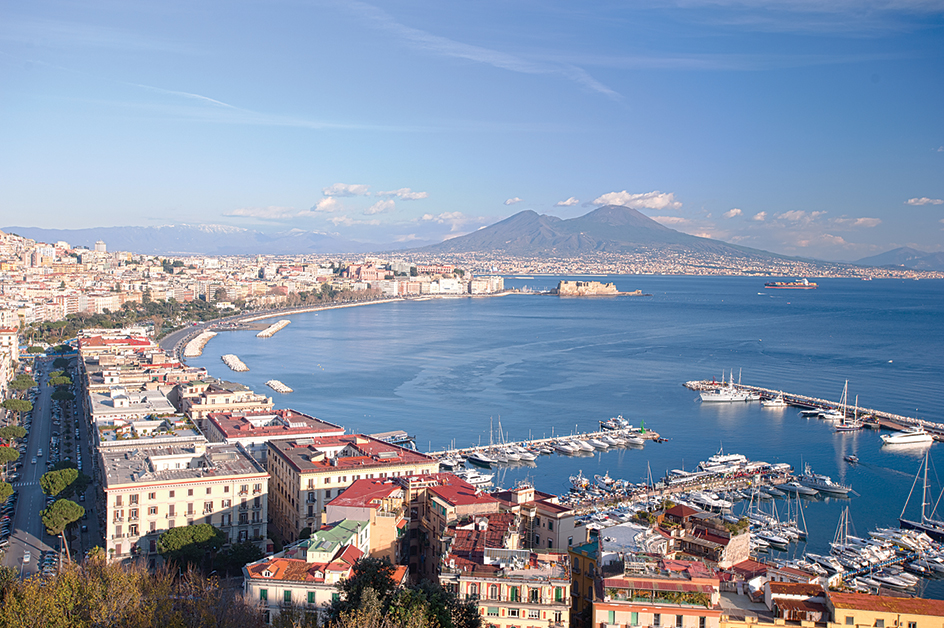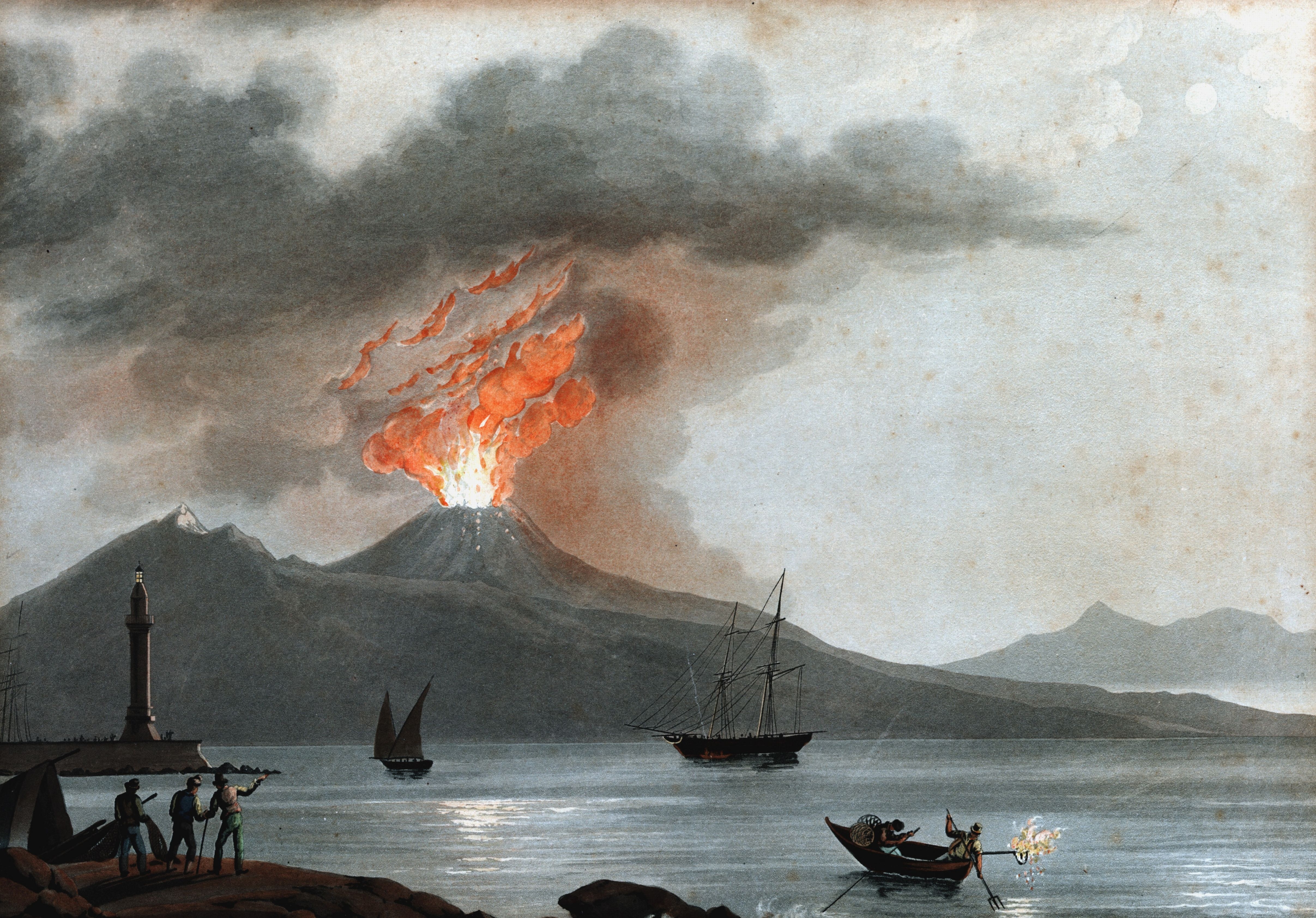Naples, << NAY puhlz >> (pop. 914,758), is the third largest city of Italy. Only Rome and Milan are larger. Naples lies at the foot of a range of low hills on the west coast of southern Italy.

Naples ranks as a major manufacturing center, and the Bay of Naples makes it an important seaport. Tourists come from all parts of the world to see the many places of scenic and historical interest in the Naples area. The city’s name in Italian is Napoli.
About 600 B.C., Greek colonists from Cumae, 14 miles (23 kilometers) to the west, founded a town near the site of present-day Naples. The Greeks called the town Parthenope. They later renamed it Neapolis (New City), and the people of Naples are still called Neapolitans. During much of the period from the 1100’s until 1860, Naples was the capital of a kingdom. This kingdom included most of southern Italy and the island of Sicily. Since 1861, the city has been the capital of Campania, a political region of Italy.
The city.
Naples is a city of extreme contrasts, with scenes of great beauty mixed with crowded slums. In the eastern section, church spires rise above old tenement buildings and factories. The Spacca-Napoli district, with its crowded, narrow streets, forms the heart of old Naples. The newer western part of the city lies along the Riviera di Chiaia, a broad drive that runs 3 miles (5 kilometers) along the Bay of Naples. A hilly, densely populated modern section called the Vomero lies inland.

The Cathedral of St. Januarius, which was completed in 1323, honors Naples’s patron saint. A number of castles in the city recall medieval times. The castles now house museum collections or government offices. The oldest of these structures, the Castel dell’Ovo (Castle of the Egg), takes its name from its shape. The Castel Sant’Elmo, built in the 1300’s and enlarged in the 1500’s, served as a prison for many years. Other interesting places in Naples are a botanical garden and a public park. The park has one of Europe’s finest aquariums.
Loading the player...O Sole Mio
Naples lies amid some of the most spectacular scenery in Europe. Artists from many countries go there to paint pictures of the landscape or the people. Mount Vesuvius, the only active volcano on the mainland of Europe, rises from a plain 7 miles (11 kilometers) southeast of the city. The volcano’s eruption in A.D. 79 buried the ancient Roman cities of Pompeii and Herculaneum, which are within 20 miles (32 kilometers) of Naples. The ruins of these cities are important archaeological sites for the study of life in Roman times. Capri and Ischia, islands famous for their climate and scenic beauty, lie to the south across the Bay of Naples. Vineyards and citrus groves dot the hillsides on the bay’s eastern shore. Just west of Naples, the Posillipo district offers a lovely view of the Bay of Naples.

Way of life.
Music plays an important part in Neapolitan life. Such songs as “O Sole Mio,” “Funiculi, Funicula,” and “Santa Lucia” have made the city’s music familiar in many parts of the world. At the Piedigrotta, an annual music festival, the people hold an outdoor competition to choose the best of the new popular songs. The Teatro San Carlo, one of the largest opera houses in Italy, has presented the first performance of many famous operas.
Loading the player...Santa Lucia
Neapolitan food includes many varieties of dishes made with spaghetti, macaroni, or noodles. Naples is the birthplace of pizza, which a baker invented in 1889 to honor the queen of Italy. Neapolitans also eat much fish and other seafood.
The National Archaeological Museum in Naples displays one of the world’s largest collections of ancient art objects. The collection includes glassware, mosaics, paintings, pottery, and statues from Herculaneum and Pompeii; and ancient Greek sculpture. The royal palace of Capodimonte, built in the 1700’s as a residence for the kings of Naples, houses the National Gallery. The gallery owns a collection of paintings, porcelain, sculpture, and tapestries. The National Library is the largest of the city’s several libraries. The library also holds thousands of rare manuscripts. The Carthusian monastery of St. Martin, which adjoins the Castel Sant’Elmo, features a museum collection devoted to the art and history of Naples. The University of Naples Federico II, the best known of the city’s many schools and colleges, was founded in 1224 by Emperor Frederick II.
Economy.
Products manufactured in Naples include automobiles, cement, chemical products, locomotives, office machinery, ships, and textiles. The highly industrialized area in and around the city has the greatest concentration of factories in southern Italy. Ships from every part of the world use Naples’ harbor. Naples still produces many traditional wares for which it became known through the years. They include kidskin gloves, wine, and articles made of coral and tortoise shell, such as combs and jewelry. Despite its industries, Naples suffers from a high rate of unemployment.
History.
After more than a century as a Greek colony, Naples came under Roman control about 326 B.C. The city’s beauty and mild climate made it a favorite resort of wealthy Romans. The poet Virgil lived in Naples for more than 20 years and is buried on a nearby hill.
After the fall of the West Roman Empire in the A.D. 400’s, various peoples fought for control of Naples and the rest of southern Italy. The Byzantines, Franks, Lombards, Normans, and Germans controlled the city for periods during the Middle Ages. Naples came under Spanish rule in 1442, and Spain held the city for most of the next 250 years.
Austria ruled Naples in the early 1700’s. During this period, Naples was Italy’s largest city and one of the largest cities of Europe. In 1734, the city became the capital of an independent kingdom, which was called Naples. A Spanish branch of the royal Bourbon family governed this kingdom and Sicily. During the Napoleonic Wars (1796-1814), Naples had a series of French rulers, including Napoleon’s brother, Joseph Bonaparte. The Bourbons regained power in 1815. In 1816, they formally combined Naples and Sicily to form the Kingdom of the Two Sicilies, which they ruled until 1860. In 1861, the Kingdom of the Two Sicilies became part of the newly formed kingdom of Italy.
During World War II (1939-1945), bombs destroyed many buildings in central Naples and the port area. The damaged areas have been rebuilt. A housing shortage has long been a problem in Naples. Since the 1970’s, the Italian government has worked to relieve the shortage. In 1980, however, a severe earthquake destroyed many buildings in Naples. During the 1980’s, the government provided new housing outside the city. In the 1990’s, the city administration helped to modernize Naples by enlarging the airport, improving public transportation, and extending hours at museums and galleries.
See also Capri; Herculaneum; Pompeii; Sicilies, Kingdom of the Two; Vesuvius.
